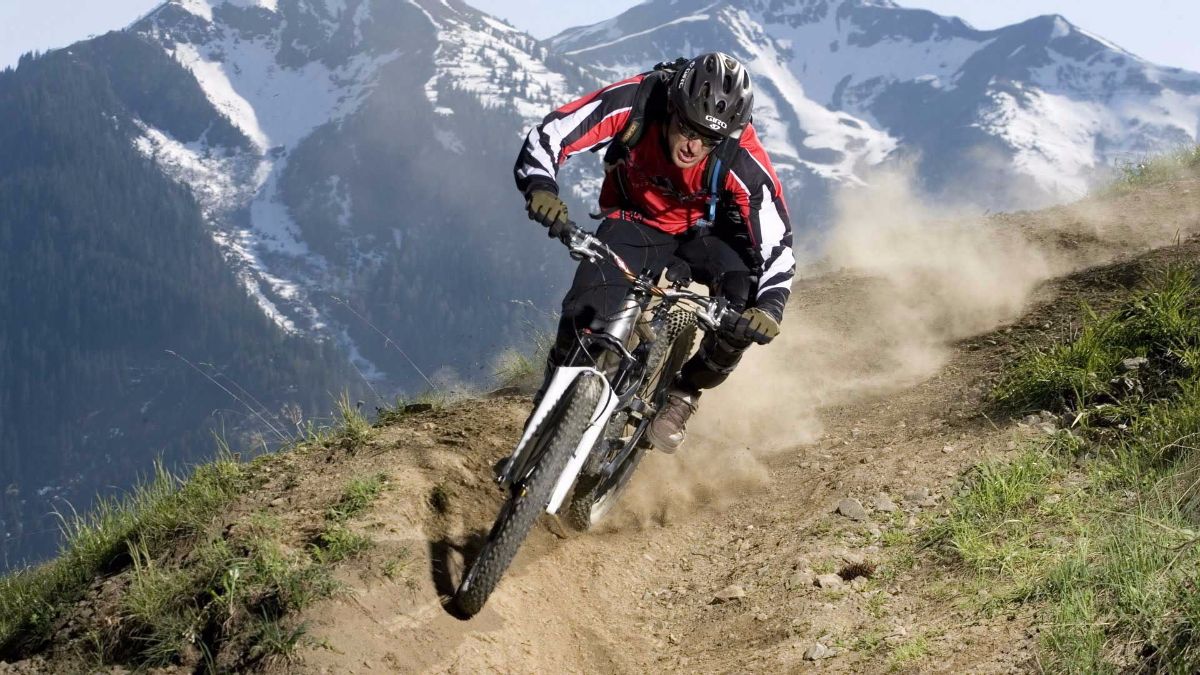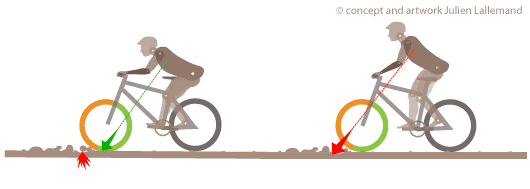Blog
Skills for Mountain Biking – A Guide [3]

In mountain biking, we have to brake more often than in any other sport. We often use the brakes to their full potential to keep going. You need to study how fast your brakes are to know the optimal braking distance for a given speed.
Always be ready to brake.
As a rule, you should have at least one finger on the brake lever. You should be ready to brake at any moment. Adjust your brakes so that your fingers are on the tip of the lever, and your forearm, wrist, and fingers are in one line.
Body mass transfer
In the chapter on balance, we already mentioned that the center of gravity is the point between the two wheels.
On the picture: The harder you brake, the further the force of gravity will push you forward.

When you brake hard, this imaginary line of your heart moves forward, like a string with a free weight attached to it. If this line moves past the point where the front wheel makes contact with the ground, your body will also start moving forward, and you will “fly over” the wheel. Braking like this is like hitting a rock – your center of gravity will move past the point of maximum balance.
On the picture: Braking or hitting an object is the same, your center of gravity should always be behind the front wheel's contact with the ground.

Shifting the balance point has a very bad effect on braking. All your weight now falls on the front wheel, and the rear wheel loses contact with the ground. And you need this contact to brake. The weight of the wheel sinks into the ground and causes it to stop. Without this, it just slides.
Brake balancing
Braking balance involves applying enough force to slow the wheels without stalling or skidding. Since braking involves transferring body weight from the rear wheel to the front, it takes more force to slow the front wheel than the rear. Braking force varies depending on how hard you brake and how steep the slope is.

It is a misconception that the rear brake is more reliable when going downhill. This is a completely false belief. You cannot stop on a steep slope with just the rear brake.
In some extreme situations, braking is virtually impossible. If the deceleration is extremely rapid or the slope is too steep, the transfer of body mass is completely horizontal. No weight is applied to the front wheel, and there is no traction to stop you. You will simply slide down in an uncontrolled manner.
Avoid getting into these situations when you're first getting into mountain biking! If this doesn't happen to you, just ride your bike until you hit something that gives you enough grip to brake again - these are already advanced skills.
Posture during braking
Braking harder than usual is like hitting a hard obstacle. Push yourself up on the seat and lean back, bringing your upper body close to the bike and allowing your arms to flex to absorb the force of the impact.
Braking sequence
When descending stairs or any kind of obstacle, you should release the brakes very quickly, just long enough to get over the obstacle. Do not add the force of hitting the obstacle to the braking force. If your bike wobbles while descending, release the brakes to avoid disturbing your center of gravity.
On the picture:Braking increases impact force and skidding.

Exercises
You can try the exercises below at any time. Start on smooth, paved roads and then repeat on other terrain. Start on paved roads and move on to hard ground, loose soil, mud, and then gravel (which is the most dangerous). Your goal should be to gradually learn to brake quickly in the shortest possible distance without skidding.
First exercise: Discover your brakes
- Find a flat surface on which you can walk 100 meters at a moderate to fast pace.
- Mark a spot that will be your braking point.
- Walk in his direction at a moderate speed.
- Get into a safe position, stand up on the chair (very lightly), both feet should be stable, the crank should be horizontal. If it is not horizontal, then you will automatically turn when braking).
- Prepare to brake by pulling your upper body back. Remember that this is the first time you will be pushing your seat back. Straighten your upper body and push it back lightly. Don't extend your arms all the way. You are now ready to brake.
- Brake.
- Brake in a straight line. Do not try to turn at this time. Apply more force to the front brake, not the rear. Do not use both brakes at the same time, apply them gradually and repeat this exercise to increase the braking effect.
If you're skidding, it means you're either applying too much force when braking or putting less weight on the rear tire. The harder you brake, the less weight is on the rear wheel and the more you skid. - Stop completely and observe how far you are from the braking point.
- Repeat the exercise until you are sure that you are doing well and are no longer slipping.
- Then choose a less steep slope where you can reach high speeds and try to stop in the shortest possible distance.
Remember!
- Don't hang on to the wheel with your arms outstretched in front of you. This position will take most of your weight off the front wheel, preventing it from providing enough initial traction to stop you. Instead, you'll continue to slide.
- If your front wheel is slipping, release your front brake immediately.
Second exercise: How to overcome rear wheel slippage?
Repeat the free-landing exercise, but use only the front brakes.
You'll notice that the braking distance is almost the same as the previous test, when you used both brakes. This means that the braking force is coming from the front wheel.
Now try using the rear brake, but very lightly. If you continue to descend uncontrollably, you are using the brake too much.
Exercise Three: How to Slow Down on a Steep Hill
- Find a paved trail, clean and dry with a steep section (approximately 20% incline)
- Type at a moderate speed.
- Assume a balanced pose while standing on a chair (see: Balance Exercises in the chapter)
- Apply the brakes (don't hold on to the brakes hard, do it gradually but quickly).
The steep slope makes it easy to descend by bike. If this is the case, you can Two Fix something:
First: Sit up straight, lean forward more (hold your feet on the chair)
Second: brake less with the rear brake, do it more with the front brake.
Repeat the exercise at high speed and try to come to a complete stop at the steepest part of the slope. Try to maintain your balance for a second (do this by looking down as much as possible, not at your bike), then release the brake.
What can we conclude after completing the exercises?
Braking firmly without slipping is essential for full control of your bike. You now know how to balance the front and rear brakes and how to avoid slipping. Braking balance is important in many typical situations. Now that you know how to overcome the effects of weight/mass transfer, you are ready to tackle a wide range of obstacles.
Always remember that you will use these same skills to brake when descending steep and slippery sections!
Translated and edited by Tea Gulua and James Dean

